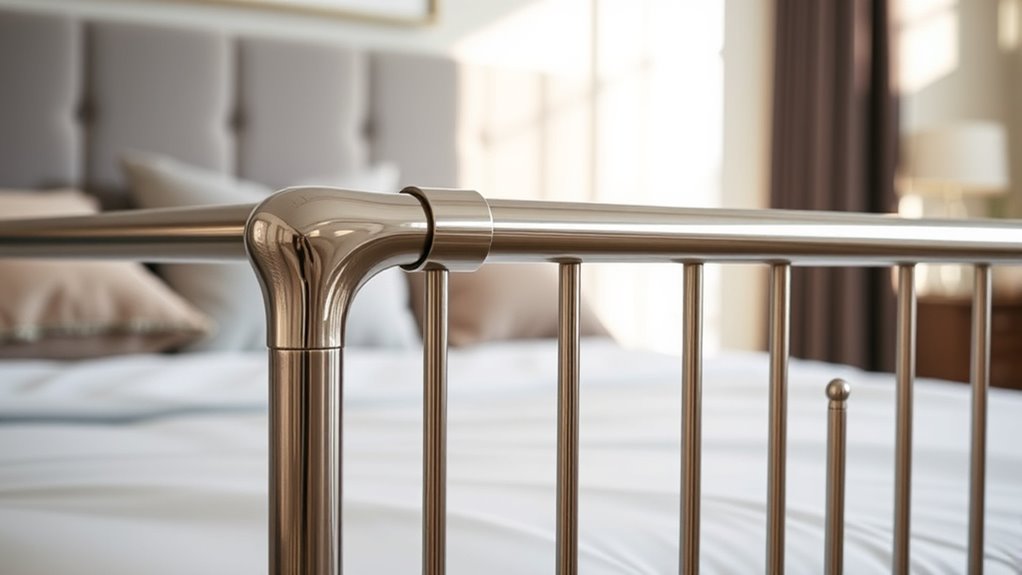Bed rails come in various types, including metal, plastic, and fabric-covered designs, each offering different safety features like padding or adjustable heights. To choose the right one, consider your safety needs, mobility, and bed compatibility. Proper installation is vital; make sure they fit snugly, use reliable locking mechanisms, and follow manufacturer instructions. Avoid common mistakes like improper setup or neglecting inspections. If you keep exploring, you’ll discover more tips for safe and effective use.
Key Takeaways
- Different bed rail types include metal, plastic, and fabric-covered options, each suited for specific safety and comfort needs.
- Proper installation involves securing locks, ensuring a snug fit, and following manufacturer instructions to prevent entrapment hazards.
- Safety standards require regular inspections, verifying locking mechanisms, and maintaining gaps within recommended limits for user protection.
- Bed rails are designed for various users, with features tailored for children, elderly, and individuals with mobility challenges.
- Alternatives like foam bumpers and removable guard rails can supplement or replace traditional bed rails for enhanced safety.
Different Types of Bed Rails and Their Features
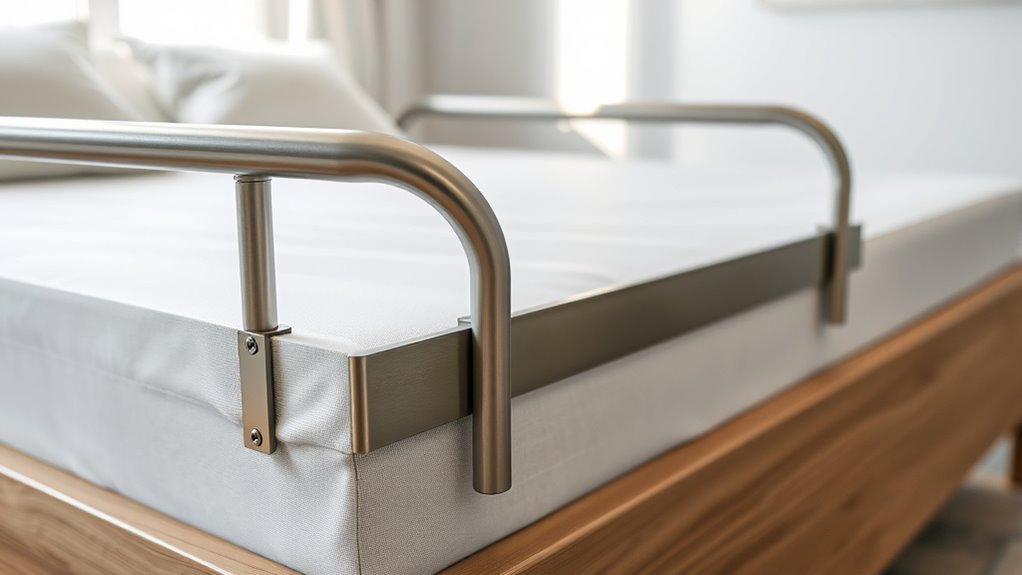
There are several types of bed rails designed to meet different safety needs and preferences. Bed rail materials vary, including metal, plastic, and fabric-covered options, offering durability and comfort. Metal bed rails are sturdy and long-lasting, while plastic models are lightweight and easy to install. Fabric-covered rails provide a softer barrier, ideal for comfort and added safety. Bed rail designs also differ; some are fixed, offering constant protection, while others are collapsible or adjustable for convenience. Some models include extra features like padding or storage pouches. Your choice depends on the level of safety needed and personal preferences for ease of use. Understanding these variations helps you select the right bed rail to ensure safety and comfort. Resources and Tools can assist in choosing the most suitable option based on safety requirements and user needs.
Choosing the Right Bed Rail for Your Needs
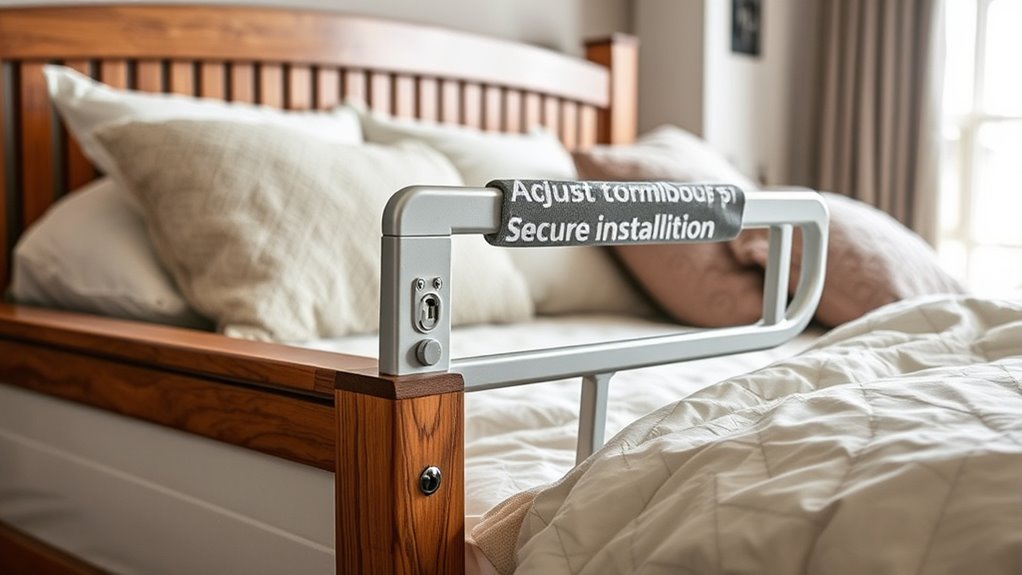
Selecting the right bed rail depends on your specific safety needs, mobility level, and daily routine. Consider how easily you can maneuver around the bed and what features will keep you secure. Your choice may also be influenced by mattress materials, as some rails fit better on certain surfaces, and bed rail aesthetics, since you might prefer a design that blends with your decor. Additionally, understanding contrast ratio can help in choosing a rail with better visibility and safety features in different lighting conditions.
Key Safety Considerations for Bed Rails

When selecting a bed rail, guarantee it fits securely and features reliable locking mechanisms to prevent accidental falls. You should also check for potential entrapment hazards that could trap fingers, limbs, or heads. Prioritizing these safety features helps protect you or your loved ones from injury. Incorporating industry transformations such as innovative safety technology can further enhance protection.
Secure Fit and Locking Mechanisms
A secure fit and reliable locking mechanisms are essential to guarantee bed rails stay firmly in place and prevent accidental falls. Without proper locking mechanisms, the rails may shift or detach, risking injury. Ensuring a secure fit involves checking that the rails tightly latch onto the bed frame and align correctly. Look for features like push-button locks, slide-in locks, or automatic locking systems that engage securely every time. Incorporating AI-driven safety features can also enhance the reliability of locking mechanisms by detecting and alerting users to potential disengagements or malfunctions. Consider these key points: – Easy-to-operate locking mechanisms for quick adjustments – Strong, durable materials for long-lasting secure fit – Clear indicators that confirm the lock is engaged – Compatibility with various bed sizes and styles – Resistance to accidental unlocking or disengagement A good locking system provides peace of mind and enhances safety during use.
Avoiding Entrapment Hazards
To guarantee safety, it’s essential to prevent bed rails from creating entrapment hazards that could cause injury or suffocation. Entrapment hazards occur when gaps or spaces in the bed rail are large enough for a person to get trapped or stuck, especially around the head, neck, or limbs. To reduce these risks, regularly check that the rails fit snugly and securely, with no gaps exceeding safety standards. Keep safety awareness in mind by inspecting the bed rail’s design and ensuring it meets manufacturer guidelines. Proper installation is critical; loose or improperly fitted rails increase entrapment risk. Always follow safety recommendations and stay vigilant to maintain a safe sleeping environment, minimizing the chance of entrapment hazards and protecting your loved ones from harm. Additionally, understanding local building codes and permits can help ensure that safety standards are met during installation.
How to Properly Install Bed Rails

Start by gathering all the necessary tools to make installation smoother. Next, confirm the bed frame is secure before attaching the rails. Finally, carefully follow the manufacturer’s instructions to ensure a safe and proper fit. Attention to detail during installation can help prevent potential safety issues and improve the overall durability of the bed rails.
Gather Necessary Tools
Before you begin installing bed rails, gather all the necessary tools to guarantee a smooth process. Having the right equipment ensures you can handle various bed rail materials and maintain bed rail aesthetics. Here’s what you’ll need:
- Phillips and flat-head screwdrivers
- Adjustable wrench
- Level for proper alignment
- Measuring tape for accurate placement
- Allen wrenches or hex keys, if applicable
Preparing these tools beforehand helps prevent interruptions and keeps your project on track. Make sure your tools are in good condition to avoid stripping screws or damaging bed rail components. Taking the time to gather everything ensures you can focus on the installation itself, resulting in a secure and visually appealing setup that complements your bed’s design. Proper tool organization makes the process quicker and more efficient.
Secure Bed Frame First
Securing the bed frame is the essential first step before attaching the bed rails, as a stable foundation guarantees everything lines up correctly. Make sure your frame is sturdy and level to prevent shifting during installation. Different bed rail designs require secure anchoring points, so double-check your frame’s compatibility. Using quality bed rail materials like steel or hardwood can enhance stability. To keep your setup aligned, consider this quick reference:
| Bed Rail Design | Suitable Bed Frame Materials |
|---|---|
| Adjustable | Metal or reinforced wood |
| Fixed | Solid wood or steel |
| Folding | Lightweight metals |
A firm, well-secured bed frame simplifies attaching the rails and ensures safety during use. Proper initial setup lays the groundwork for a safe, reliable bed. Additionally, ensuring the expiration of materials such as padding or connectors can prevent potential safety hazards over time.
Follow Manufacturer Instructions
To guarantee your bed rails are installed safely and correctly, it’s essential to follow the manufacturer’s instructions carefully. Proper installation ensures the bed rail design provides maximum user comfort and safety. Missteps can lead to instability or discomfort, so pay close attention to each step. Always read the entire manual before starting, and double-check compatibility with your bed frame. Keep tools handy and work in a clean area. Remember, each product may have specific requirements, so don’t assume one size fits all. Proper adherence minimizes risks and enhances safety. Additionally, understanding Self Watering Plant Pots can help you appreciate the importance of correct setup and maintenance. Proper adherence minimizes risks and enhances safety.
Common Mistakes to Avoid When Using Bed Rails
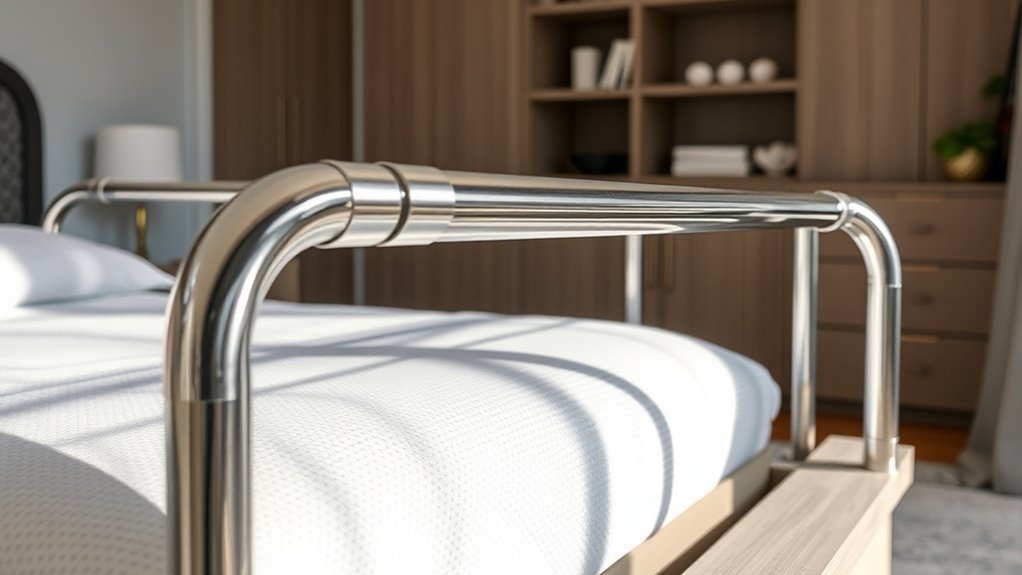
Using bed rails improperly can pose serious safety risks, so it’s important to be aware of common mistakes. One mistake is neglecting bed rail aesthetics, which can lead to choosing a design that clashes with your room or discourages regular use. Another mistake is ignoring bed rail customization options, which might result in an ill-fitting or uncomfortable setup. Failing to secure the rails properly or skipping installation instructions can cause accidents or injuries. Additionally, using a bed rail that’s unsuitable for your bed type or personal needs can compromise safety. Always consider both function and appearance when selecting and installing bed rails. Recognizing the importance of proper security procedures can help prevent accidents or misuse with bed rails. Avoid these pitfalls to ensure safety, comfort, and a cohesive look that encourages proper use.
Maintenance and Inspection of Bed Rails

Regular maintenance and inspection of bed rails help guarantee they stay safe and functional over time. You should regularly check for loose bolts, worn or damaged parts, and ensure all bed rail accessories are secure. Keep the bed rail clean by performing bed rail cleaning to prevent dirt buildup that could compromise safety. Inspect for rust or corrosion, especially if the bed is in a humid environment. Verify that the latches and locking mechanisms work smoothly and securely. Don’t forget to examine padding and foam for wear. By following these steps, you reduce risks and extend the lifespan of your bed rails.
- Tighten loose bolts and screws
- Check for rust or corrosion
- Ensure bed rail accessories are secure
- Test locking mechanisms
- Clean regularly to prevent dirt buildup
Bed Rails for Different Age Groups and Conditions

Bed rails come in various designs tailored to the needs of different age groups and health conditions. If you have young children, bed rails for children help prevent falls and provide a sense of security, often featuring softer materials and fun designs. For seniors, bed rails for seniors offer support for getting in and out of bed, reducing fall risk and aiding mobility. These rails are typically sturdier, with features like adjustable height or side support handles. When choosing bed rails, consider safety features suitable for the user’s age and condition, such as easy grip, stability, and ease of installation. Proper selection guarantees safety and comfort, whether for a child needing protection or an elderly person requiring assistance.
Legal and Regulatory Standards for Bed Rail Safety

You need to understand the legal and regulatory standards that guarantee bed rail safety. Federal safety regulations, along with state and local laws, set clear requirements you must follow. Industry standards also guide you in maintaining compliance and protecting users effectively.
Federal Safety Regulations
Have you ever wondered how safety standards protect you or your loved ones from bed rail accidents? Federal safety regulations set strict guidelines to ensure bed rail design minimizes risks. These regulations address critical aspects like strength, stability, and ease of use to prevent entrapment or falls. They also require manufacturers to test products thoroughly before market release. Compliance with safety regulations helps guarantee your bed rails are safe and reliable. To give you a clearer picture, here are key points:
- Adequate strength and durability
- Proper gap sizes to prevent entrapment
- Clear labeling and instructions
- Use of non-toxic, durable materials
- Regular testing and certification processes
Following these federal standards helps keep you safer and ensures the bed rails meet high safety benchmarks.
State and Local Laws
Ever wonder how state and local laws influence bed rail safety beyond federal regulations? You need to be aware that state law often sets specific standards for bed rail design, installation, and use, which can vary markedly across regions. Local regulations may impose additional safety requirements or restrictions to protect residents and prevent accidents. For example, some areas mandate safety testing or certification before bed rails can be sold or used in healthcare settings. It’s crucial to stay informed about these laws to ensure compliance and avoid penalties. While federal regulations provide a baseline, understanding your state’s legal landscape helps you select safe, compliant bed rails. Always check local regulations before purchasing or installing bed rails to meet all legal safety standards.
Industry Standards Compliance
Understanding the industry standards and regulatory requirements for bed rails is key to ensuring safety and compliance. These standards ensure that bed rail materials are durable, non-toxic, and safe for users. Manufacturers must hold proper certifications to demonstrate adherence to safety protocols. Compliance involves following regulations from organizations like the FDA, ASTM, and CPSC. You should verify that:
- Bed rails meet material safety standards
- Manufacturer certifications are current and legitimate
- Product designs minimize entrapment risks
- Safety warnings are clearly labeled
- Installation instructions follow regulatory guidelines
Staying informed about these standards helps you select products that are both safe and legally compliant, reducing risks for users and avoiding legal issues. Always prioritize certified, compliant bed rails to ensure safety and peace of mind.
Alternatives to Traditional Bed Rails
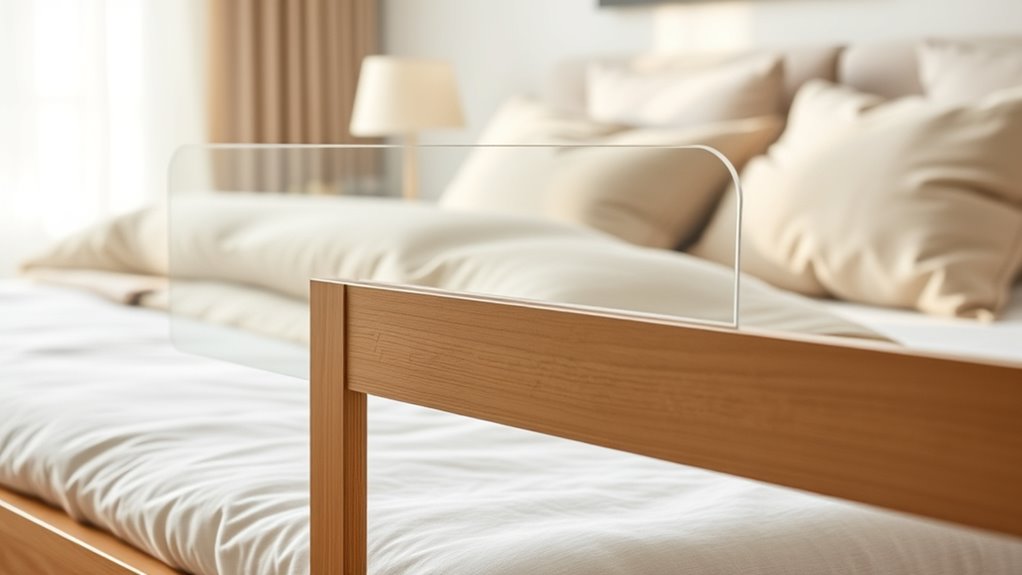
While traditional bed rails are a common safety option, many people seek alternatives that offer similar protection without the bulk or restriction. You might explore alternative sleeping arrangements, such as low-profile beds or mattress extensions, which prevent falls without adding barriers. Ergonomic bed design also plays a role, providing better support and positioning to reduce the need for physical barriers. Consider this comparison:
| Option | Benefits |
|---|---|
| Bedside Sleep Aids | Soft barriers or foam bumpers for gentle protection |
| Adjustable Beds | Custom height and position for safer sleep environment |
| Floor-Level Sleeping | Eliminates fall risk entirely |
| Bed Attachments | Removable guard rails or netting for flexibility |
These alternatives can enhance safety while maintaining comfort and independence.
Tips for Ensuring Safe Use of Bed Rails
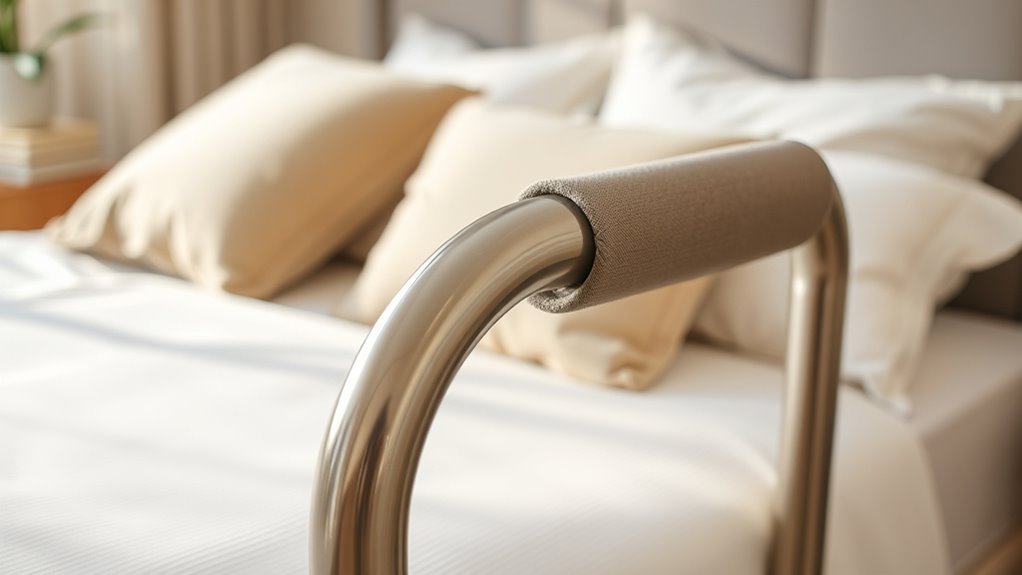
Are you confident that your bed rails are used safely? To prevent accidents, regularly check that your bed rail accessories are secure and in good condition. Always follow manufacturer instructions for installation and use. Consider using bed rail alternatives if safety concerns arise or if they don’t fit your needs. Keep the area clear of clutter to avoid tripping or entanglement. Educate everyone in the household about safe bed rail practices. In conclusion, monitor the user’s behavior to ensure they’re not attempting risky maneuvers that could lead to falls or injuries. Remember, safety starts with proper use and regular maintenance. Incorporating these tips helps minimize hazards and ensures your bed rails provide effective support and protection.
Frequently Asked Questions
Are Bed Rails Suitable for Children Under Age 6?
You might wonder if bed rails are suitable for children under age 6. Generally, for child safety, it’s better to choose age-appropriate bed rail types designed specifically for young children. While some bed rails can prevent falls, they may pose risks for younger kids if not properly installed. Always check manufacturer guidelines and consult safety recommendations to make certain the bed rail type you select is safe for your child’s age and size.
How Do Bed Rails Impact Sleep Quality?
You might wonder how bed rails impact sleep quality. They can reduce sleep disruption by preventing falls, giving you peace of mind and allowing you to rest more comfortably. However, if not installed properly, they might cause discomfort or restrict movement, potentially disturbing your sleep. Overall, when used correctly, bed rails can enhance comfort and safety, leading to a more restful night’s sleep.
Can Bed Rails Be Used on Adjustable Beds?
You can use bed rails on adjustable beds, but it’s crucial to check for adjustable bed compatibility. Not all rails fit well with the bed’s movements, so look for those designed for adjustable frames. Make sure the bed rail adjustments align with your bed’s positions to prevent safety issues. Proper installation and choosing the right rails ensure safety and functionality, allowing you to enjoy the benefits without compromising comfort.
What Materials Are Safest for Bed Rail Construction?
Think of bed rail materials as the sturdy backbone of safety; they’re your first line of defense. You should look for materials that meet strict safety standards, like powder-coated metal, sturdy plastic, or solid wood. These materials are durable, non-toxic, and less likely to cause injury. Always check that the bed rail construction adheres to safety standards, ensuring peace of mind and a secure environment for your loved ones.
Do Insurance Policies Cover Bed Rail Installation Costs?
You might wonder if insurance coverage includes bed rail installation costs. Usually, standard health insurance doesn’t cover the expenses for installing bed rails, as they’re often considered a safety or home modification. However, if your doctor recommends them for medical reasons, some policies or Medicare might help cover part of the costs. It’s best to check with your insurance provider to understand your specific coverage for installation costs.
Conclusion
Choosing the right bed rail and using it safely can greatly reduce fall risks, especially since falls from beds account for nearly 60% of hospital injuries among older adults. By understanding the different types, proper installation, and safety tips, you can guarantee a secure environment for yourself or loved ones. Remember, staying informed and cautious helps prevent accidents and promotes peace of mind—making bed rails a reliable safety solution.
